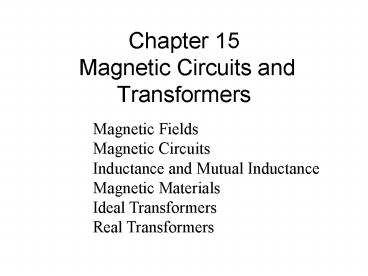Chapter 15 Magnetic Circuits and Transformers - PowerPoint PPT Presentation
1 / 70
Title:
Chapter 15 Magnetic Circuits and Transformers
Description:
1. Understand magnetic fields and their interactions with moving charges. 2. Use the right-hand rule to determine the direction of the magnetic field ... – PowerPoint PPT presentation
Number of Views:72
Avg rating:3.0/5.0
Title: Chapter 15 Magnetic Circuits and Transformers
1
Chapter 15 Magnetic Circuits and Transformers
Magnetic Fields Magnetic Circuits Inductance and
Mutual Inductance Magnetic Materials Ideal
Transformers Real Transformers
2
Chapter 15 Magnetic Circuits and Transformers
1. Understand magnetic fields and their
interactions with moving charges. 2. Use the
right-hand rule to determine the direction of the
magnetic field around a current-carrying wire or
coil.
3
3. Calculate forces on moving charges and current
carrying wires due to magnetic fields. 4.
Calculate the voltage induced in a coil by a
changing magnetic flux or in a conductor
cutting through a magnetic field. 5. Use Lenzs
law to determine the polarities of induced
voltages.
4
6. Apply magnetic-circuit concepts to determine
the magnetic fields in practical devices. 7.
Determine the inductance and mutual
inductance of coils given their physical
parameters. 8. Understand hysteresis,
saturation, core loss, and eddy currents in cores
composed of magnetic materials such as iron.
5
9. Understand ideal transformers and solve
circuits that include transformers. 10. Use the
equivalent circuits of real transformers
to determine their regulations and power
efficiencies.
6
(No Transcript)
7
MAGNETIC FIELDS
Magnetic flux lines form closed paths that are
close together where the field is strong and
farther apart where the field is weak.
8
Flux lines leave the north-seeking end of a
magnet and enter the south-seeking end. When
placed in a magnetic field, a compass indicates
north in the direction of the flux lines.
9
(No Transcript)
10
Right-Hand Rule
11
(No Transcript)
12
Forces on Charges Moving in Magnetic Fields
13
Forces on Current-Carrying Wires
14
Flux Linkages and Faradays Law
Faradays law of magnetic induction
15
(No Transcript)
16
Lenzs Law
Lenzs law states that the polarity of the
induced voltage is such that the voltage would
produce a current (through an external
resistance) that opposes the original change in
flux linkages.
17
(No Transcript)
18
Voltages Induced inField-Cutting Conductors
19
(No Transcript)
20
Magnetic Field Intensity and Ampères Law
Ampères Law
21
22
Magnetic Field Around a Long Straight Wire
23
(No Transcript)
24
Flux Density in a Toroidal Core
25
(No Transcript)
26
(No Transcript)
27
MAGNETIC CIRCUITS
In many engineering applications, we need to
compute the magnetic fields for structures that
lack sufficient symmetry for straight-forward
application of Ampères law. Then, we use an
approximate method known as magnetic-circuit
analysis.
28
magnetomotive force (mmf) of an N-turn
current-carrying coil
reluctance of a path for magnetic flux
29
(No Transcript)
30
Advantage of theMagnetic-Circuit Approach
The advantage of the magnetic-circuit approach is
that it can be applied to unsymmetrical magnetic
cores with multiple coils.
31
(No Transcript)
32
Fringing
We approximately account for fringing by adding
the length of the gap to the depth and width in
computing effective gap area.
33
(No Transcript)
34
A Magnetic Circuit with Reluctances in Series and
Parallel
35
(No Transcript)
36
INDUCTANCE AND MUTUAL INDUCTANCE
37
Mutual Inductance
38
(No Transcript)
39
Dot Convention
Aiding fluxes are produced by currents entering
like marked terminals.
40
Circuit Equations for Mutual Inductance
41
(No Transcript)
42
(No Transcript)
43
(No Transcript)
44
MAGNETIC MATERIALS
The relationship between B and H is not linear
for the types of iron used in motors and
transformers.
45
(No Transcript)
46
Energy Considerations
47
(No Transcript)
48
Core Loss
Power loss due to hysteresis is proportional to
frequency, assuming constant peak flux.
49
(No Transcript)
50
Eddy-Current Loss
Power loss due to eddy currents is proportional
to the square of frequency, assuming constant
peak flux.
51
Energy Stored in theMagnetic Field
52
(No Transcript)
53
IDEAL TRANSFORMERS
54
(No Transcript)
55
(No Transcript)
56
Transformer Summary
- We assumed that all of the flux links all of the
windings of both coils and that the resistance of
the coils is zero. Thus, the voltage across each
coil is proportional to the number of turns on
the coil.
57
2. We assumed that the reluctance of the core is
negligible, so the total mmf of both coils is
zero.
3. A consequence of the voltage and current
relationships is that all of the power
delivered to an ideal transformer by the
source is transferred to the load.
58
(No Transcript)
59
Analysis of a Circuit Containing an Ideal
Transformer
60
(No Transcript)
61
Impedance Transformations
62
(No Transcript)
63
(No Transcript)
64
(No Transcript)
65
REAL TRANSFORMERS
66
(No Transcript)
67
Variations of theTransformer Model
68
(No Transcript)
69
Regulation and Efficiency
70
(No Transcript)































